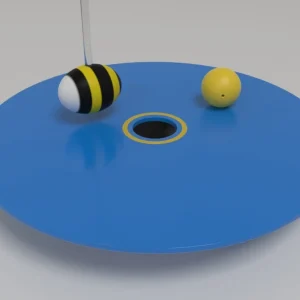Bee Mazes
Overview
Rats and mice, widely-utilized animal models in research, share similarities in some aspects. Known for their genetic similarity to humans, these rodents are extensively employed in various scientific studies. Unlike other animal models like Drosophila, rats and mice offer unique advantages such as their larger size and physiological similarities to humans. Their widespread use in research is attributed to these characteristics, making them preferred choices for studies ranging from disease models to behavioral research.

-

Bee Soccer
Read more -

Bee Spatial Reorientation
$1,490.00 Add to cart -

Bee Reward Expectations Apparatus
$1,390.00 Add to cart -

Bee Radial Arm
$1,390.00 Select options This product has multiple variants. The options may be chosen on the product page -

Bumblebee Y-Maze
$1,690.00 Add to cart -

Path Regularity Mazes
$990.00 Add to cart -

Honeybee Y Maze
$990.00 Add to cart -

Modified Y Choice For Bees
$990.00 Add to cart
Bees Behaviors and Characteristics
Scientific Name: | Apis mellifera |
Family Name: | Apidae |
Habitat: | Varied habitats including forests; meadows and urban areas |
Length: | Approximately 15 mm (worker bee). |
Diet: | Nectar and pollen collected from flowers. |
Life Span: | Worker bees: 4-6 weeks in summer; up to 6 months in winter; Queen bee: 2-5 years. |
Sexual Maturity: | Worker bees: 3 weeks; Queen bee: 10-12 days. |
Gestation Period: | Eggs hatch in 3 days; Larval stage lasts 6 days |
Social Behavior: | Highly social with complex colony structure; Communication through dances and pheromones. |
History
Bees, originally domesticated millennia ago, have adapted to diverse environments globally and have played crucial roles in scientific research since the early 20th century. Notably, their utility was underscored by pioneering studies conducted by researchers like Karl von Frisch and Martin Lindauer in the mid-1900s (von Frisch, 1950; Lindauer, 1954). Throughout the 20th century, bees became increasingly prominent in studies of animal behavior and ecology (Seeley, 1985).
A pivotal figure in promoting bees as premier models in behavioral research was American biologist Charles Michener. Michener’s seminal work on the social behavior of bees laid the foundation for understanding colony dynamics and communication (Michener, 1964). His research, alongside that of others like Tom Seeley and Gene Robinson, established bees as invaluable tools in studying social insects and their ecological interactions (Seeley, 1995; Robinson, 1992).
The development of techniques like the waggle dance decoding by von Frisch and the use of radio frequency identification (RFID) tagging in the 1990s revolutionized the study of bee behavior. These technologies allowed researchers to track individual bees within colonies and understand their roles in pollination and hive maintenance (von Frisch, 1967; Robinson et al., 2005).
Today, bees remain crucial in ecological and agricultural research, offering unparalleled insights into pollination ecology, environmental health, and the effects of pesticides. Their complex social structure, sophisticated communication methods, and crucial role in global food security make them ideal models for studying the impacts of environmental change and developing sustainable agricultural practices.
Training Considerations and Best Practices
Training bees for research purposes involves careful consideration of their natural behaviors and capabilities. Here are some key considerations and best practices:
Understanding Bee Behavior: Bees are highly social insects with complex behaviors such as foraging, communication through dances, and hive construction. Researchers should have a solid understanding of these behaviors to design effective experiments.
Selection of Experimental Subjects: Not all bees within a colony will behave identically. Researchers often select worker bees (non-reproductive females) for studies due to their role in foraging and hive maintenance.
Habitat and Housing: Bees used in research are typically housed in specialized hives that mimic their natural environment as closely as possible. This includes providing adequate space, ventilation, and access to foraging areas.
Training Techniques: Techniques such as classical conditioning can be used to train bees to associate specific stimuli (like colors or scents) with rewards (like food). This can be achieved by presenting the stimulus alongside a sugar reward, encouraging the bees to recognize and respond to the stimulus.
Experimental Design: Clear experimental protocols should be established to ensure consistency and reproducibility. This includes controlling variables that may influence bee behavior, such as time of day, weather conditions, and hive health.
Data Collection Methods: Researchers often use technologies like RFID tags or unique markings to track individual bees and monitor their movements and interactions within the hive or during foraging flights. This data is crucial for understanding social dynamics and individual contributions to colony functions.
Ethical Considerations: Researchers must prioritize the welfare of the bees throughout the study. This includes minimizing stress during handling, ensuring adequate nutrition, and maintaining overall hive health.
Collaboration with Beekeepers: Collaboration with experienced beekeepers can provide valuable insights into bee management and behavior. Beekeepers can also assist in obtaining healthy colonies and ensuring proper care and maintenance during the study.
Interpretation of Results: Results from bee research should be interpreted in the context of their natural behaviors and ecological roles. This helps in drawing meaningful conclusions about bee biology, ecology, and their contributions to ecosystems.
Publication and Sharing of Findings: Sharing research findings with the scientific community and the public promotes awareness of bee biology and conservation efforts. It also encourages collaboration and further advancements in bee research.

